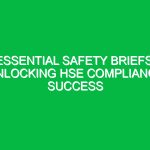Welcome and Introduction
Good morning, team! Today, we’re here for a vital toolbox talk focusing on an essential aspect of our daily operations—Securing a Construction Site. As we gather to embark on another productive day, let’s take a moment to discuss how securing our construction site can significantly impact our health, safety, and Environment (HSE). The measures we put in place today will not only protect us but also ensure the integrity of our worksite and the surrounding community.
Why Securing a Construction Site Matters
Securing a construction site is not just about preventing unauthorized access; it’s about establishing a safe working environment for everyone involved. Construction sites can be hazardous places with heavy machinery, high elevations, and various materials that can pose risks if not managed properly. When we think about securing our site, we’re looking at several key aspects:
- Preventing accidents and injuries
- Protecting valuable equipment and materials
- Ensuring compliance with legal and regulatory Standards
- Maintaining the site’s environmental integrity
By focusing on these aspects, we not only enhance our Safety but also improve our operational efficiency and reputation.
Key Components of Securing a Construction Site
To effectively secure a construction site, we must pay attention to several critical areas:
Access Control
Establishing clear access points is crucial. We should have:
- Designated entry and exit points that are monitored
- Signage that indicates restricted areas
- Identification badges for employees and authorized personnel
Think about a scenario where an unauthorized person wanders onto the site. This can lead to serious accidents. By controlling access, we minimize that risk significantly.
Site Perimeter Security
A strong perimeter is vital. This can include:
- Fencing that is tall enough to deter intruders
- Security lighting to illuminate the site at night
- Security personnel to patrol the area
Imagine a late-night incident where equipment is stolen due to inadequate perimeter security. We can prevent such losses by investing in robust security measures.
Safety Signage and Communication
Clear communication is essential on a construction site. We need to:
- Post Safety signs that are visible and understandable
- Conduct regular safety briefings to keep everyone informed
- Encourage a culture of open communication where team members can voice concerns
For example, if someone notices a potential hazard but feels hesitant to speak up, that could lead to an accident. Ensuring everyone knows they can communicate freely is crucial.
Regular Inspections and Maintenance
Part of securing our site involves regular inspections. This includes:
- Checking the condition of fencing and gates
- Ensuring safety equipment is in working order
- Monitoring for any unusual activity or trespassing
Consider a situation where a piece of equipment breaks down due to lack of maintenance. This not only causes delays but can also create safety Hazards. Regular inspections help us avoid such issues.
Emergency Preparedness
Having a clear emergency response plan is vital. This includes:
- Identifying potential emergencies specific to our site
- Training all employees on emergency protocols
- Conducting drills to ensure everyone knows what to do in a crisis
For instance, in case of a fire, knowing the evacuation routes and having fire extinguishers readily available can save lives. We must take these preparations seriously.
Understanding Regulations and Standards
Compliance with regulations is non-negotiable. Here are some key regulations we should be aware of:
- The Occupational Safety and Health Administration (OSHA) standards
- Local building codes and zoning laws
- Environmental regulations specific to construction activities
Failure to comply can lead to severe penalties, including fines and work stoppages. More importantly, it can jeopardize our safety and the safety of those around us.
Real-Life Examples and Hypothetical Scenarios
Let’s consider a real-life example: a construction site that failed to secure its perimeter ended up facing significant theft, resulting in the loss of thousands of dollars in equipment. This not only delayed the project but also put the workers’ safety at risk as they had to work with limited resources.
On the other hand, imagine a hypothetical scenario where a team conducts a thorough inspection before starting work. They find a broken fence and repair it immediately, preventing unauthorized access. This proactive approach not only ensures safety but also fosters a culture of responsibility among the team.
Best Practices for Securing a Construction Site
Now that we’ve covered the essential components, let’s discuss some Best Practices to implement:
- Always wear identification badges while on site.
- Participate in regular safety Training sessions.
- Report any suspicious activities immediately to site management.
- Ensure all tools and equipment are stored securely when not in use.
- Review emergency Procedures regularly and keep them accessible.
Encouraging Open Discussion
Before we wrap up, I’d like to encourage an open discussion. What challenges have you faced regarding site security? Are there any suggestions for improvements? Your insights are invaluable as we work together to create a safer environment.
Conclusion
In conclusion, securing a construction site is a shared responsibility that requires vigilance, communication, and proactive measures. Today, we discussed the importance of access control, perimeter security, safety signage, regular inspections, and emergency preparedness. By applying these principles, we can significantly reduce risks and enhance our safety culture.
Thank you for taking the time to engage in this toolbox talk. Your commitment to safety is crucial in maintaining a secure work environment. Let’s carry this knowledge forward and make our construction site as safe as possible. Remember, safety starts with each of us!


